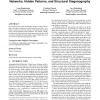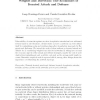38 search results - page 4 / 8 » Preserving Privacy in Social Networks Against Neighborhood A... |
WWW
2007
ACM
14 years 8 months ago
2007
ACM
In a social network, nodes correspond to people or other social entities, and edges correspond to social links between them. In an effort to preserve privacy, the practice of anon...
PVLDB
2008
13 years 7 months ago
2008
We identify privacy risks associated with releasing network data sets and provide an algorithm that mitigates those risks. A network consists of entities connected by links repres...
CCR
2010
13 years 7 months ago
2010
In recent years, academic literature has analyzed many attacks on network trace anonymization techniques. These attacks usually correlate external information with anonymized data...
SP
2010
IEEE
13 years 11 months ago
2010
IEEE
—Social networking sites such as Facebook, LinkedIn, and Xing have been reporting exponential growth rates. These sites have millions of registered users, and they are interestin...
CN
2011
13 years 2 months ago
2011
Vulnerability of networks against one-shot decapitation attacks has been addressed several times in the literature. A first study on how a network can best defend itself by reple...


